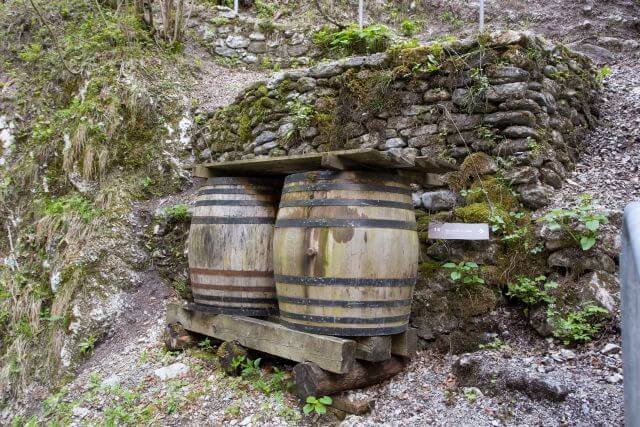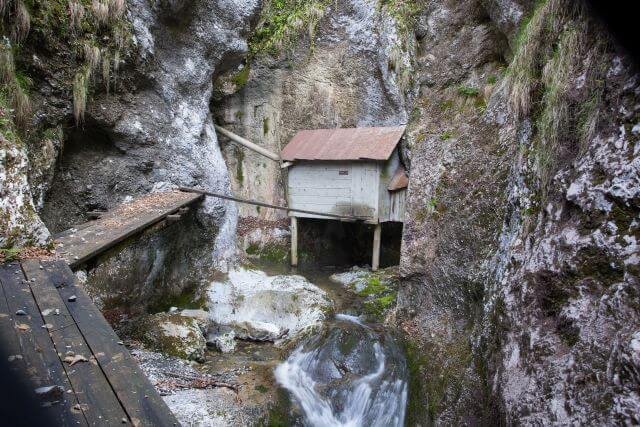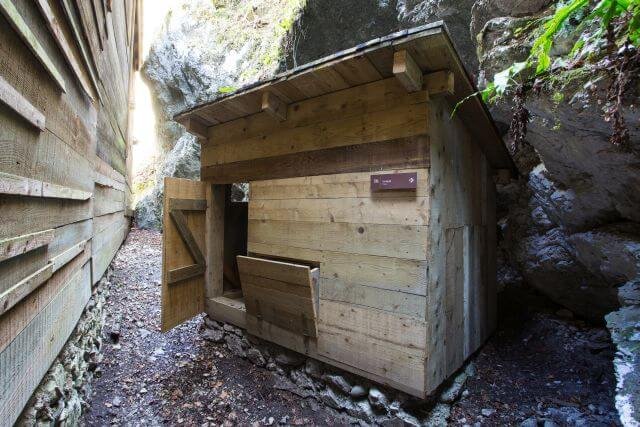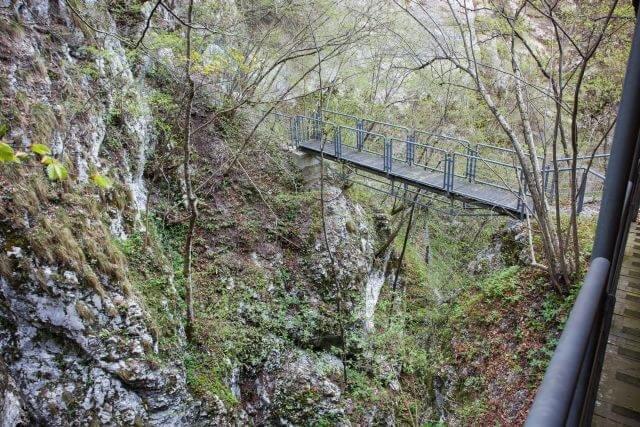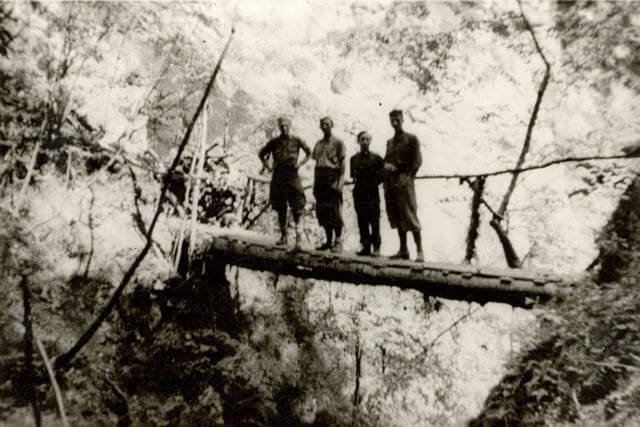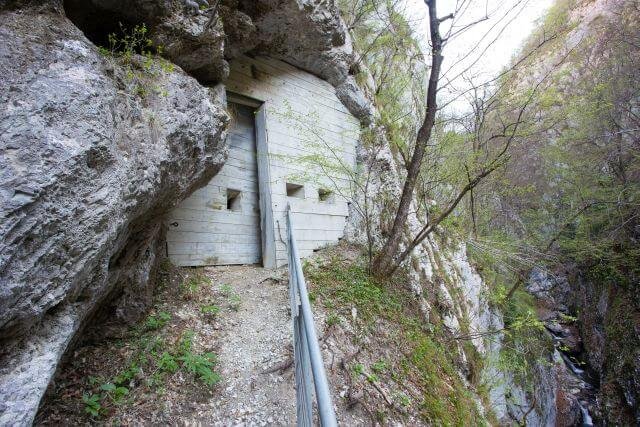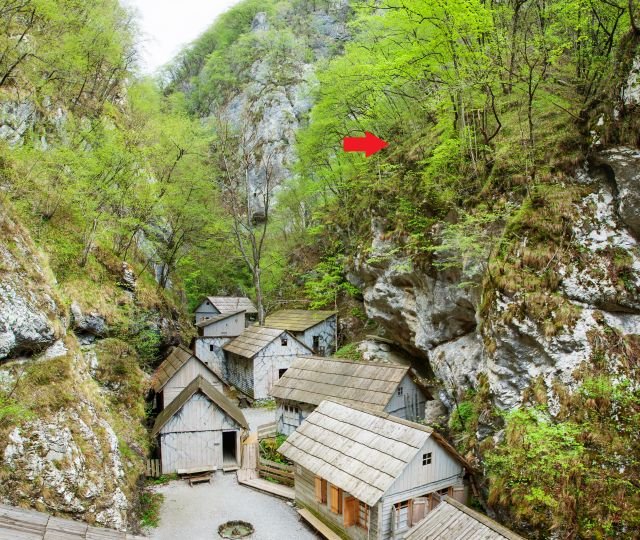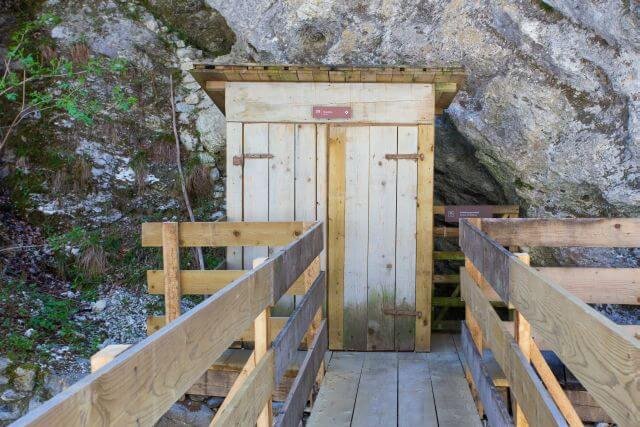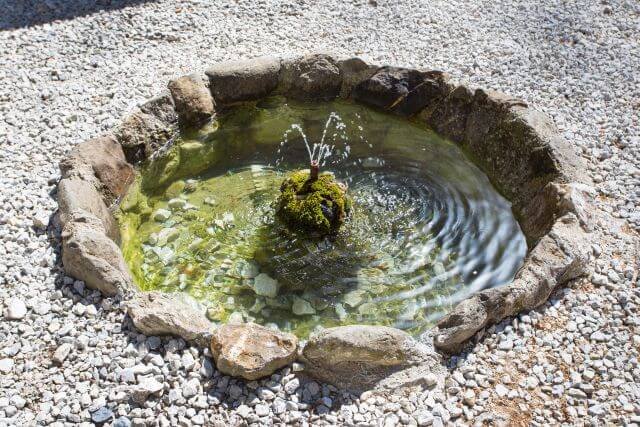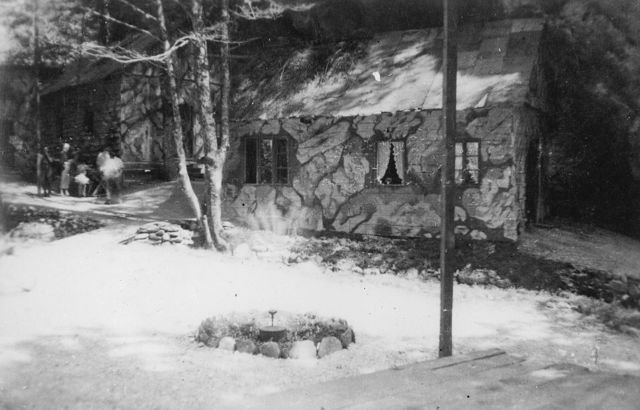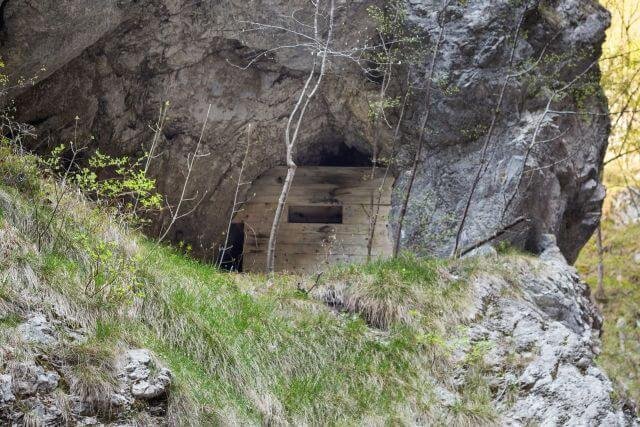In addition to the basic information about each cabin, you can also find the contents of the information boards in them.

1 - Cabin for the Wounded with Shelter This cabin for 36 people was built in May 1944. The shelter underneath offered enough space for 28 immobile patients. Ventilation was provided by pipes that connected the underground facility to the bank of the nearby stream at three points. The ceiling of the shelter was separated from the cabin and covered with a 60 cm thick layer of sand. This was to prevent a fire in the cabin from spreading to the shelter. During the last enemy offensive in March 1945, when the occupying troops stayed nearby for a few days and even launched an attack on the gorge, the wounded had to spend several days in this underground hiding place. 2 - Isolation Cabin The isolation cabin, built in May 1944, was intended for the wounded with infectious diseases and for dying patients. 78 of about 600 wounded patients died in the hospital, mostly due to open wounds on the abdominal organs, followed by head and chest injuries. The most deadly of the infections was gas gangrene - an infection in which gas accumulates in the tissue. 3 - Surgery Cabin The cabin was built in early December 1944. The vestibule contained a pharmacy and a sterilisation area. Operations were rarely performed without anaesthesia, and the surgeons usually had ether and other drugs at their disposal. There was a lack of antibiotics, blood and plasma. The staff also had to improvise when disinfecting surgical linen and instruments.
Sanitary material and medicines were sent by field organisations, and help also came through secret connexions from as far away as Milan and Graz. In March 1944 the first consignment of sanitary material arrived from the Allies. Various apparatuses for immobilising injured limbs were made in the hospital by nurse Jože Čerin.
4 - Physicians' Room and Room for the Wounded The cabin was built in January 1944. Until the construction of the surgery cabin, this cabin housed a surgery room, which also served as the administrator's working and living room. In the second part, there was a room for the wounded. Intended for women, this room was jokingly called the cloister. But as there were not many women, men also lay in this room. Among them was Harold C. Adams, an American Air Force pilot. He was one of hundreds of Allied pilots rescued by Slovenian partisans. In addition to Adams, about 100 wounded soldiers of other nationalities were treated in this hospital: the most numerous were Italians, followed by members of various nations of the former Soviet Union and Yugoslavia (Russians, Croats, Serbs …) and a number of Frenchmen, Poles, Austrians, and Americans. 5 - X-ray Cabin An X-ray machine was very rare in partisan hospitals. To house it, a special cabin was built in March 1945. The interior of the cabin was lined with cardboard and black cloth obtained from Allied parachutes. After the war, the X-ray machine was taken from the hospital and continued to serve its purpose for several more years, for the last time in Vransko. It was returned in 1967. Together with most of the authentic museum specimens, the X-ray machine was completely destroyed in the flood of September 2007. These items have been replaced by copies and substitute specimens dating from the period of the hospital's operations. 6 - Stretcher Storage A space under an overhanging rock served as a storage for stretchers, which were used to transport the wounded. 7 - Kitchen A kitchen area was located in cabin no. 8. Just before the end of the war, in April 1945, a new cabin was built in which there was a kitchen and a small room serving as a storage. Meat storage was created beneath an overhanging rock near the cabin, where it was very cold. Initially, the hospital was supplied with food from the nearby surroundings, and later on from the Vipava Valley. In March 1944, Allied aid began to arrive. There was no lack of food, except during enemy attacks, when supply was stopped. 8 - Room for the Wounded and Dining Room This was the first cabin in the gorge, built in December 1943. It had two rooms: a room for the wounded and a kitchen. The staff lived in the attic, the men above the room for the wounded, the women above the kitchen and the dining room. The room had enough space for 50 patients. The furniture - windows, stoves and bunks - came from the abandoned Italian military barracks. 9 - Workshop, Storage, Room for Wounded Officers, and Commissioner's Room This multi-purpose cabin was built in 1944. Inside the cabin there was a laundry and sewing room or workshop, a food storage, a room for three patients, and a pharmacy. The attic was occupied by the political commissioner, who was a member of the administration primarily responsible for the political and moral atmosphere in the hospital.
10 - Cabin for Hospital Staff A self-sacrificing and reliable staff was needed for the construction of new facilities, transport of injured soldiers and sanitary materials, guard and defence tasks, in the kitchen, tayloring and woodworking workshops, in the laundry, and for other auxiliary tasks. Their numbers grew concurrently with the number of patients. A list dating from 2nd May 1945 indicates that the hospital had 46 staff members. A considerable number of healed patients became members of the hospital staff. They were lodged in cabin attics, until the workers’ cabins were built in September 1944. In these cabin, the lower room was intended for the male staff members – primarily guards, and the attic was used by female nurses. 11 - Laundry and Washroom The laundry was built in October 1944. Three laundresses were responsible for clean linen. They used water from the stream to wash the laundry. A bathtub with a stove was brought from the military barracks in Cerkno, after which people were able to take baths.
12 - Lice Disinfection Barrel Lice were a serious problem in the army. For this reason, a lice disinfection barrel stood in front of the laundry, and was used to boil the garments of injured people arriving at the hospital covered in lice. An ordinary petrol barrel was used for this purpose. 13 - Invalid Care Facility The disabled people who were no longer able to fight were moved to the newly built disabled care facility in March 1945. This facility had two rooms: a bedroom with bunk beds brought from a quite distant German military post, and a living room whose furnishings were made by a male nurse and carpenter, Jože Vovk. In front of the facility, there was a sun terrace.
The disabled people were very active in the cultural life of the hospital. They had their own choir, directed by a cultural worker, Albin Waingerl – nicknamed Čriček, Cricket. They contributed to the wall newspaper, which grew into a literary magazine entitled Patient's Bulletin in the summer of 1944. Čriček also prepared various lectures for them. Commemorations and meetings featuring political speeches, singing, recitations, and sketches were frequently organised. Revolutionary songs often raised the morale and instilled the hope that liberation was near. For those at Franja, the fervently awaited freedom arrived on 5 May 1945.
14 - Water Tank Water for drinking and cooking was initially obtained from the mountain stream. Because it was often muddy and filled with sand after storms, a water supply system was installed at the end of February or March 1944. Drinking water was collected in two wooden, 500-litre barrels placed beneath the water spring in the northern part of the gorge. Water pipes and sinks were brought from an abandoned Italian military barracks in Cerkno. The water supply was connected to the washroom, kitchen, physicians' room, and the surgery cabin.
15 - Electric Plant At the end of February 1944, an electric plant began to be planned at the hospital. Its construction was carried out by Ivan Goljat. A concrete dam was built, but considerable difficulties were caused by spring storms in May and June. Materials – wires, switches, insulators – were obtained from the military barracks in Cerkno, and also from an abandoned copper mine above Planina. The plant was put into trial operation on 10 June 1944. A water turbine with a direct current generator was installed in the cabin. This turbine was used only for lighting purposes. The X-ray machine could only be used after the hospital acquired a petrol engine with an alternating current generator. 16 - Pigsty The hospital staff was not allowed to give any remaining food to nearby farmers, and so they used it to rear two pigs. The pigsty was set up behind Cabin no. 9 with a provisional access path running below the cabin.
17 - Upper Bridge The construction of the bridge, which crossed the gorge approximately 12 m above the mountain stream bed, formed part of the preparations for the construction of two new cabins in the barely accessible northern part of the gorge. The cabins were built, but subsequently demolished after the first attack on the gorge in April 1944. The bridge was preserved because it provided access to the shelter for the wounded. 18 - Shelter for the Wounded The shelter, probably built in March 1944, also served as a defence bunker. It had sufficient space to accommodate 16 wounded people. The entrance to the bunker was barricaded with a double wood panel. The half-metre-wide space in between was filled with sand in order to stop bullets. Embrasures were incorporated into the wall, which was then coated with camouflage paint and covered with moss and branches.
19 - Shelter for the Wounded In the rocky slope of Mali Njivč, 30 m above the surgery cabin, another shelter for the wounded was erected in March or April 1944. Bunk beds for 26 wounded people were placed in the shelter, which is no longer accessible today.
20 - Latrine The latrine was probably set up in January 1944. Finding a suitable location for it proved difficult, as the latrine had to be removed from the future surgery room.
21 - Fountain In May 1944, new cabins were being hastily constructed in the gorge. After a two-day absence, Dr. Franja stood in the sand-covered yard and looked in astonishment at a five-point star made of moss, in the centre of which was a fountain made from a shower fixture. The patients and staff were as excited as children. They were praised for their resourcefulness, but also admonished. Owing to the danger of the star being noticed from the air, it had to be removed, but the fountain was preserved. 22 - Defence bunker The first defence bunker was built in February 1944. Taking advantage od a natural rocky cave above the gorge, they enforced the entrance with a double wood panel filled with sand and stones. The bunker was only accessible via a 3-metre-long ladder. 1 - Cabin for the Wounded with Shelter This cabin for 36 people was built in May 1944. The shelter underneath offered enough space for 28 immobile patients. Ventilation was provided by pipes that connected the underground facility to the bank of the nearby stream at three points. The ceiling of the shelter was separated from the cabin and covered with a 60 cm thick layer of sand. This was to prevent a fire in the cabin from spreading to the shelter. During the last enemy offensive in March 1945, when the occupying troops stayed nearby for a few days and even launched an attack on the gorge, the wounded had to spend several days in this underground hiding place. Entrance to the shelter “Just before it grew dark, the attack began. It rumbled and roared for more than half an hour. When everything calmed down, I went to see if the wounded people in bunkers needed any assistance. Through a tube extending from the bunker beneath the cabin, nurse Jožko reported that a wounded soldier, Gino, was suffering from severe flatulence. He felt as if his stomach was about to explode. Because the bunker exit could not be opened, I asked him if he had scissors and a scalpel. The answer was affirmative. I gave him instructions for surgery. In the stream bed near the opening of the ventilation pipe, I waited for his message. Luckily, the patient pulled through.” (Franci Derganc, surgeon) Care for wounded “Of course we changed the dressings of each wounded person every day. All the nurses always took part in this procedure. We kept to the same order: Jože undressed the wounds, the physician cleaned everything up during the examination, Lida and I handed her the tampons and instruments, and then Danilo redressed the wound. There was complete silence in the room while the dressings were being changed. This was the most important task besides surgery, for the wounded fighters knew that the healing of their severe wounds depended on it. After dressing was finished, everyone enjoyed a cigarette.” (Pavla Leban, nurse) The care of the injured and the patients was mostly the responsibility of the nursing staff. They were trained at the workplace and in two courses organised in the hospital. The first course, which was led by doctors Franci Derganc and Franja Bojc Bidovec was attended by nine nurses. The second course was attended by another five nurses. The head nurse, Lidija Zlatoper, was the only nurse who had completed secondary medical school in Gorica. 2 - Isolation Cabin The isolation cabin, built in May 1944, was intended for the wounded with infectious diseases and for dying patients. 78 of about 600 wounded patients died in the hospital, mostly due to open wounds on the abdominal organs, followed by head and chest injuries. The most deadly of the infections was gas gangrene - an infection in which gas accumulates in the tissue. The medical record of the patient “In October 1944, a patient with typhoid fever was brought to the hospital, the only such case in the history of Franja. He was placed in the isolation cabin. His suffering, especially during the last night before his death, is impossible to describe. I was on duty. When I came to him, he was already deeply delirious and sweat was pouring from his entire body. I reported to the physician on his condition, but she had nothing to give him.” (Franc Šmid – Vinotok, nurse) 3 - Surgery Cabin The cabin was built in early December 1944. The vestibule contained a pharmacy and a sterilisation area. Operations were rarely performed without anaesthesia, and the surgeons usually had ether and other drugs at their disposal. There was a lack of antibiotics, blood and plasma. The staff also had to improvise when disinfecting surgical linen and instruments.
Sanitary material and medicines were sent by field organisations, and help also came through secret connexions from as far away as Milan and Graz. In March 1944 the first consignment of sanitary material arrived from the Allies. Various apparatuses for immobilising injured limbs were made in the hospital by nurse Jože Čerin.
Pharmacy “We received assistance from field organisations. During every collection campaign for the hospital, the packages also contained dressing materials. Packets were rarely purchased in pharmacies, because the purchase of medicines was controlled by the occupiers and their helpers. The packages sent were mostly sewn from old sheets, diapers or linen. Everything was carefully washed, hemmed, and delivered to the communication post with a letter or sent by courier.” (Franja Bojc Bidovec, physician) Protocol of the surgical team “Physician Bogdan Brecelj examined me soon after my arrival at the hospital. I was told he would operate on me, and that I should prepare for it. They asked me if I was used to alcohol. I said no. They brought me a bottle of homemade schnapps, supposedly slivovitz, and told me to drink from it for as long as I could. And I really did drink as much as I could, because I began to realize what was coming. My whole body was shaking as I swallowed the schnapps that I wasn’t used to. I was becoming stiff, insensitive, my head was spinning, I was dizzy and swaying…” (Dušan Furlan, wounded soldier) 4 - Physicians' Room and Room for the Wounded The cabin was built in January 1944. Until the construction of the surgery cabin, this cabin housed a surgery room, which also served as the administrator's working and living room. In the second part, there was a room for the wounded. Intended for women, this room was jokingly called the cloister. But as there were not many women, men also lay in this room. Among them was Harold C. Adams, an American Air Force pilot. He was one of hundreds of Allied pilots rescued by Slovenian partisans. In addition to Adams, about 100 wounded soldiers of other nationalities were treated in this hospital: the most numerous were Italians, followed by members of various nations of the former Soviet Union and Yugoslavia (Russians, Croats, Serbs …) and a number of Frenchmen, Poles, Austrians, and Americans. Viktor Volčjak Volčjak was born as the son of a working class family in Virmaše near Škofja Loka. He studied medicine in Ljubljana and Zagreb. First he worked as a doctor in Ptuj and then opened a medical practice in Žiri. Before joining the partisans, he occasionally treated the wounded. In November 1943, together with the staff, he founded this partisan hospital in the Pasice gorge in Dolenji Novaki and became its first manager. From here he was transferred to the post of the head of the medical department of the 9th Corps. Later he organised a health service in the hills of Brda. After the war, he worked as a doctor in Ljubljana, Belgrade, Zagreb, and again in Ljubljana. He specialised in internal medicine and earned a doctorate in military health care. He also studied the history of partisan health care and wrote several articles on this subject. Franja Bojc Bidovec She was born in a peasant family in the village of Nemška vas near Ribnica in the Dolenjska region. After graduating from the classical grammar school in Ljubljana, she decided to pursue a medical career. She studied in Ljubljana, Belgrade, and Zagreb. She worked as a doctor in Bohinjska Bistrica and in Ribnica. Because of her participation in the liberation movement, she was imprisoned several times. From January 1944 until the end of the war, she ran this partisan hospital, which was named after her already in the wartime. After the war, she worked in the military hospitals of Gorica, Trieste, and Ljubljana until 1946, and then in the gynaecology and obstetrics clinics in Belgrade and Ljubljana. Harold Adams Harold Adams was an American Air Force pilot whose plane was shot down in February 1944. He injured his leg when landing on the Šentviška plateau and was taken to hospital. He lay in this cabin. On the wall next to his bunk bed, which was lined with paper, he made little crosses to mark the days spent in the hospital. The staff of the Franja Partisan Hospital enabled the American lieutenant pilot to return home safely. After the war, nurse Danilo Šuligoj, with whom he had remained in contact, sent him this very note as a souvenir. His son Cory Adams donated it to the museum several years ago. 5 - X-ray Cabin An X-ray machine was very rare in partisan hospitals. To house it, a special cabin was built in March 1945. The interior of the cabin was lined with cardboard and black cloth obtained from Allied parachutes. After the war, the X-ray machine was taken from the hospital and continued to serve its purpose for several more years, for the last time in Vransko. It was returned in 1967. Together with most of the authentic museum specimens, the X-ray machine was completely destroyed in the flood of September 2007. These items have been replaced by copies and substitute specimens dating from the period of the hospital's operations. X-Ray Apparatus “The hospital’s greatest acquisition was a wonderful x-ray machine obtained in March 1945 from Žiri, formerly owned by Dr. Demšar, a deceased physician. We built a veritable palace for it, 4×3 m large, and lined it with cardboard and a black parachute. We immediately started to use it, as we had longed to have one in countless difficult situations.” (Franja Bojc Bidovec, physician) 6 - Stretcher Storage A space under an overhanging rock served as a storage for stretchers, which were used to transport the wounded. Stretcher Storage, June 1945 7 - Kitchen A kitchen area was located in cabin no. 8. Just before the end of the war, in April 1945, a new cabin was built in which there was a kitchen and a small room serving as a storage. Meat storage was created beneath an overhanging rock near the cabin, where it was very cold. Initially, the hospital was supplied with food from the nearby surroundings, and later on from the Vipava Valley. In March 1944, Allied aid began to arrive. There was no lack of food, except during enemy attacks, when supply was stopped. Never empy pot “Thanks to various sources of food supply, we almost always had three warm meals a day. In the winter, however, the meals were too monotonous and mostly consisted of the local Primorska “minestrone”. During the last attack, when the supply was completely blocked, we cooked meals once a day, only at night. As a supplement, dry food was distributed to the bunkers before the attack.” (Franja Bojc Bidovec, physician) 8 - Room for the Wounded and Dining Room This was the first cabin in the gorge, built in December 1943. It had two rooms: a room for the wounded and a kitchen. The staff lived in the attic, the men above the room for the wounded, the women above the kitchen and the dining room. The room had enough space for 50 patients. The furniture - windows, stoves and bunks - came from the abandoned Italian military barracks. Contruction of a post “The path used to carry the required materials was extremely arduous. On this path, we had to climb up and down, traverse rocks, overcome several metres of height difference, walk along the edges of vertiginous depths, and avoid any large precipices. We were more used to carrying a rifle than boards. When comrade Volčjak noticed our discouragement, he set an example by loading a few boards on his shoulders and rushing off with them across all the previously mentioned obstacles and barriers. We took courage and followed him, as we had no intention of falling behind.” (Ivan Goljat, military leader) Alongside the central hospital in the Pasice gorge, which was also named Department B, an additional 10 smaller hospital departments were built and managed by the central facility. Around 300 patients with minor injuries were treated in these departments. Medical work was performed by nurses; only the Pokljuka Department in Jelovica had an on-duty physician, Antonio Ciccarelli. “Doctor Franja visited our department on several occasions. Each time she inspected the wounds and gave the patients a little courage to help them overcome their suffering. Although we did not have the comfort and sterility that are common in hospitals today, the patients’ wounds did not fester and even healed quickly. The wounded were sent from the Central Hospital (from the gorge) to our department when they no longer needed medical attention.” (Alojz Plesničar – Gigi, nurse in Department A) Rudi Katrašnik - Gašper “I revealed the plans to build the hospital to Gašper first because I trusted him. Whenever I looked at his sky-blue eyes, childish smile and strong build, I felt I would dare to undergo the worst trials with such a comrade. He was the first male nurse in the gorge, and later worked at the communication post, which was discovered by German occupying forces in April 1944. As he was rescuing the last wounded person, he was hit by the enemy bullet at the threshold of the mill. The death’s door opened and closed after him so quickly that he didn’t get a chance to tell us anything; through his sacrifice, he continues to condemn all the tyrants of this world.” (Viktor Volčjak, physician) Communication posts were the outposts of the partisan hospitals. Franja Hospital had several such spots, which changed frequently. The best known were on the farms Podnjivč, Log, Cmilk and in the Praprotnik Mill by the Črna brook, which is where Rudi Katrašnik – Gašper worked. The medical work at the communication posts was independent, demanding and responsible. The nurse had to be able to judge where to send an injured person in relation to their injury. The most seriously injured were taken to the Central Hospital, those with less severe wounds to a smaller ward, while people with minor wounds remained with the nurse at the communication post. 9 - Workshop, Storage, Room for Wounded Officers, and Commissioner's Room This multi-purpose cabin was built in 1944. Inside the cabin there was a laundry and sewing room or workshop, a food storage, a room for three patients, and a pharmacy. The attic was occupied by the political commissioner, who was a member of the administration primarily responsible for the political and moral atmosphere in the hospital.
Unjustly accused “The calvary began in July, when they led me from one department to another, from bunk to bunk, asking patients to say what they have against me, to reveal all my mistakes. Two astonished eyes stared out of every bunk. The patients were shocked, confused, afraid. They knew how much care I was devoting to them, and answered according to their conscience.” (Franja Bojc Bidovec, physician) Also recorded in the history of the Franja Partisan Hospital is an experience that particularly left its mark on two doctors, Viktor Volčjak and Franja Bojc Bidovec. In July 1944, following complaints from some influential patients and the hospital commissioner, criminal proceedings were brought against the aforementioned doctors at the Higher Military Court of the 9th Corp. They were accused of an unfriendly attitude towards the staff and patients, negligent performance of duties, and of belittlement of the Allied flag. The trial was concluded in September 1944 with an order from the Chief Public Prosecutor then SNOS Presidium – the government at the time – stating that there was no reason to prosecute the suspects and that the charges were not admissible. Food Storage “In March 1994, our food storage was filled to the top after the Allies began to provide substantial aid to the 9th Corps. For several nights, trucks with food supplies drove to Log, where our staff reloaded them onto farm wagons, transported them to Podnjivč, and then carried them to the hospital.” (Franja Bojc Bidovec, physician) At first, food was supplied to the hospital by the members of national liberation committees – bodies of people’s government – in Novaki and Cerkno. After the number of injured people and staff rose sharply, they received food from the Vipava valley with the help of special supply units of the partisan army. Allied aid began to arrive in March 1944. On holidays, the people of Primorska remembered the wounded and sent them numerous packages with food and goodies by courier. The management of the hospital thanked in writing all the various organizations and committees which had collected and sent food packages. It survived the flood The multi-purpose cabin built in May 1944 was the only cabin that survived the flood of September 2007, and is also the only cabin containing a number of original in-built structural elements. The wooden cabins built as emergency shelters during wartime had to be continuously renewed in the decades following the war. The high humidity in the gorge accelerated the decay of wooden parts, and various types of damage also occurred. 10 - Cabin for Hospital Staff A self-sacrificing and reliable staff was needed for the construction of new facilities, transport of injured soldiers and sanitary materials, guard and defence tasks, in the kitchen, tayloring and woodworking workshops, in the laundry, and for other auxiliary tasks. Their numbers grew concurrently with the number of patients. A list dating from 2nd May 1945 indicates that the hospital had 46 staff members. A considerable number of healed patients became members of the hospital staff. They were lodged in cabin attics, until the workers’ cabins were built in September 1944. In these cabin, the lower room was intended for the male staff members – primarily guards, and the attic was used by female nurses. A shoemaker Alois “An Austrian named Alois Trummel came to the hospital. He was in his fifties, a former German soldier who joined the partisan army. He had at least 20 large abscesses on the back of his neck. He was in deep pain, frequently moaning: »Schmerzen, schmerzen.« He did not speak Slovenian. When he recovered, he stayed on at the hospital as a shoemaker.” (Franc Šmid – Vinotok, male nurse) Shoemaker Alojz 11 - Laundry and Washroom The laundry was built in October 1944. Three laundresses were responsible for clean linen. They used water from the stream to wash the laundry. A bathtub with a stove was brought from the military barracks in Cerkno, after which people were able to take baths.
12 - Lice Disinfection Barrel Lice were a serious problem in the army. For this reason, a lice disinfection barrel stood in front of the laundry, and was used to boil the garments of injured people arriving at the hospital covered in lice. An ordinary petrol barrel was used for this purpose. “Life in the hospital was pleasant, the work was organised, everyone had their own duties. The nurses cared for the wounded day and night, the laundresses worked constantly all day long. The rest of us were bearers and guards at the same time, I was given the additional task of disinfecting patients’ garments. This was an important and responsible job, as we would otherwise soon be invaded by lice throughout the hospital. The most important piece of equipment for my work was the disinfection barrel, which had naturally not been purchased in a store, but adapted for this purpose from an ordinary petrol barrel by our skilful comrades.” (Božo Benedik, guard) 13 - Invalid Care Facility The disabled people who were no longer able to fight were moved to the newly built disabled care facility in March 1945. This facility had two rooms: a bedroom with bunk beds brought from a quite distant German military post, and a living room whose furnishings were made by a male nurse and carpenter, Jože Vovk. In front of the facility, there was a sun terrace.
The disabled people were very active in the cultural life of the hospital. They had their own choir, directed by a cultural worker, Albin Waingerl – nicknamed Čriček, Cricket. They contributed to the wall newspaper, which grew into a literary magazine entitled Patient's Bulletin in the summer of 1944. Čriček also prepared various lectures for them. Commemorations and meetings featuring political speeches, singing, recitations, and sketches were frequently organised. Revolutionary songs often raised the morale and instilled the hope that liberation was near. For those at Franja, the fervently awaited freedom arrived on 5 May 1945.
Evacuation to southern Italy In the beginning of August 1944, the physician Franc Podkoritnik – nicknamed Daddy selected the severely injured patients who were no longer fit to fight, but were able to endure a long journey without major medical aid. We gathered at a very early hour, there were 31 of us, and were told that we had been chosen for transfer to Allied hospitals in southern Italy. We bid farewell to those comrades who were not able to join us, and headed for the valley. (Andrej Fon – Slavko, injured soldier) The enemy’s longlasting offensive in the summer of 1944 represented an increasingly greater threat to the partisan units, hinterland activities, and in particular the partisan hospitals in the area of the 9th Corp. For this reason, in August the units of the Corp carried out, in agreement with the Headquarters of the Slovenian Partisan Army, the evacuation of injured people from Primorska and Gorenjska to the Notranjska region, from where they were transported by plane to southern Italy. The evacuation of injured soldiers to southern Italy was a form of Allied assistance to the national liberation movement. Some 80 wounded people were evacuated from the Franja and Pavla partisan hospitals. The campaign was carefully conceived and organised. Five brigades comprised of approx. 3000 fighters participated in the rescue of injured soldiers. Meetings and Commemorations “The days on which meetings were organised were our holidays in the hospital. How we talked about these meetings beforehand! Who would play? What would they play? What would they sing? And how much studying had to be done before meetings. Cook Anica stood in front of the stove in the kitchen with a ladle in one hand and her role in the other, Jože transported an injured soldier while practicing a recitation in his thoughts, or out loud.” (Albin Weingerl – Čriček (cricket), cultural worker) Among invalids “We lay in the cabins. The most difficult time was when the sun was going down and dusk was nearing. Every evening at that time, we heard the sounds of a revolutionary song accompanied by a guitar or an accordion. Everyone, even the most severely injured patients, sang in spite of our grave wounds. This was an important part of treatment, which instilled us with courage and gave us faith in the days to come. In the disabled care facility, which was built for us in 1945, we had beautiful new bunks, large windows in the bedroom, as well as a special room for study and entertainment.” (Ivan Flajs, injured soldier) 14 - Water Tank Water for drinking and cooking was initially obtained from the mountain stream. Because it was often muddy and filled with sand after storms, a water supply system was installed at the end of February or March 1944. Drinking water was collected in two wooden, 500-litre barrels placed beneath the water spring in the northern part of the gorge. Water pipes and sinks were brought from an abandoned Italian military barracks in Cerkno. The water supply was connected to the washroom, kitchen, physicians' room, and the surgery cabin.
15 - Electric Plant At the end of February 1944, an electric plant began to be planned at the hospital. Its construction was carried out by Ivan Goljat. A concrete dam was built, but considerable difficulties were caused by spring storms in May and June. Materials – wires, switches, insulators – were obtained from the military barracks in Cerkno, and also from an abandoned copper mine above Planina. The plant was put into trial operation on 10 June 1944. A water turbine with a direct current generator was installed in the cabin. This turbine was used only for lighting purposes. The X-ray machine could only be used after the hospital acquired a petrol engine with an alternating current generator. 16 - Pigsty The hospital staff was not allowed to give any remaining food to nearby farmers, and so they used it to rear two pigs. The pigsty was set up behind Cabin no. 9 with a provisional access path running below the cabin.
17 - Upper Bridge The construction of the bridge, which crossed the gorge approximately 12 m above the mountain stream bed, formed part of the preparations for the construction of two new cabins in the barely accessible northern part of the gorge. The cabins were built, but subsequently demolished after the first attack on the gorge in April 1944. The bridge was preserved because it provided access to the shelter for the wounded. Upper Bridge, July 1944 18 - Shelter for the Wounded The shelter, probably built in March 1944, also served as a defence bunker. It had sufficient space to accommodate 16 wounded people. The entrance to the bunker was barricaded with a double wood panel. The half-metre-wide space in between was filled with sand in order to stop bullets. Embrasures were incorporated into the wall, which was then coated with camouflage paint and covered with moss and branches.
19 - Shelter for the Wounded In the rocky slope of Mali Njivč, 30 m above the surgery cabin, another shelter for the wounded was erected in March or April 1944. Bunk beds for 26 wounded people were placed in the shelter, which is no longer accessible today.
20 - Latrine The latrine was probably set up in January 1944. Finding a suitable location for it proved difficult, as the latrine had to be removed from the future surgery room.
21 - Fountain In May 1944, new cabins were being hastily constructed in the gorge. After a two-day absence, Dr. Franja stood in the sand-covered yard and looked in astonishment at a five-point star made of moss, in the centre of which was a fountain made from a shower fixture. The patients and staff were as excited as children. They were praised for their resourcefulness, but also admonished. Owing to the danger of the star being noticed from the air, it had to be removed, but the fountain was preserved. Fountain, July 1944
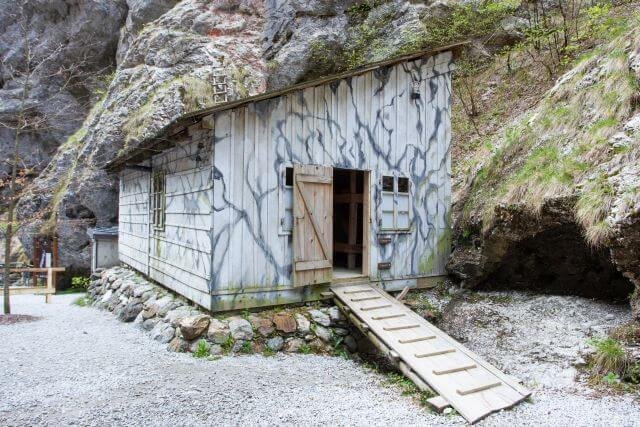
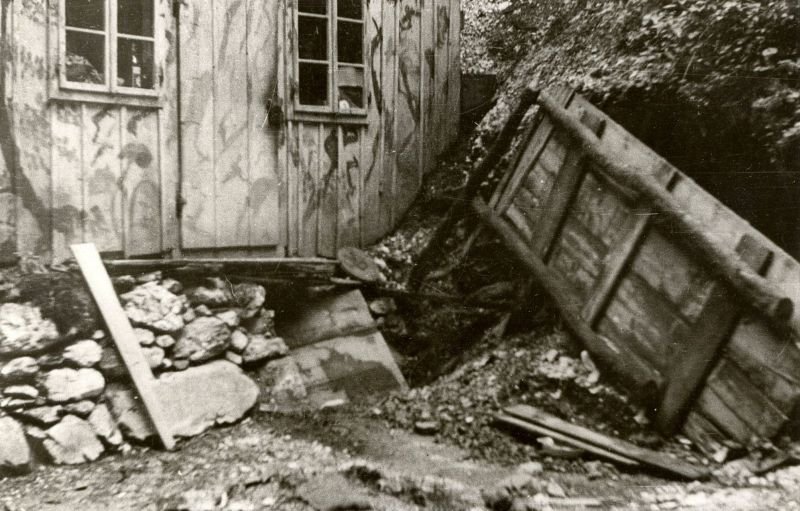
During the attack
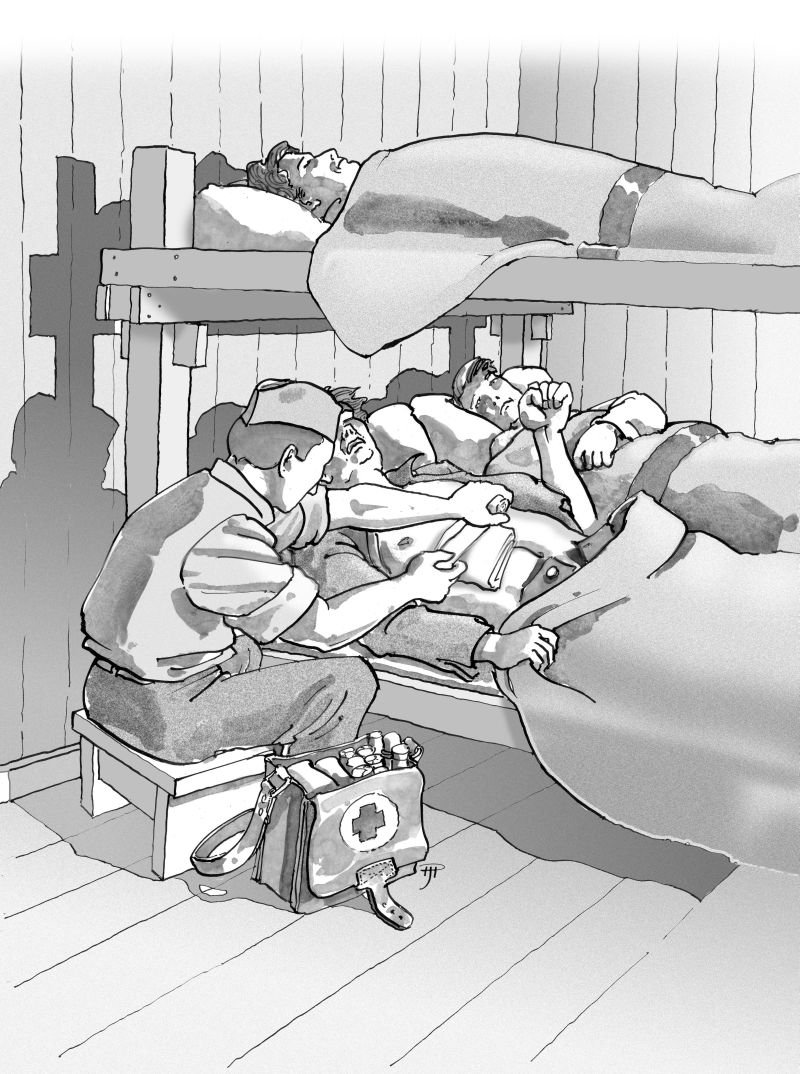
Care for wounded
Partisan nurses
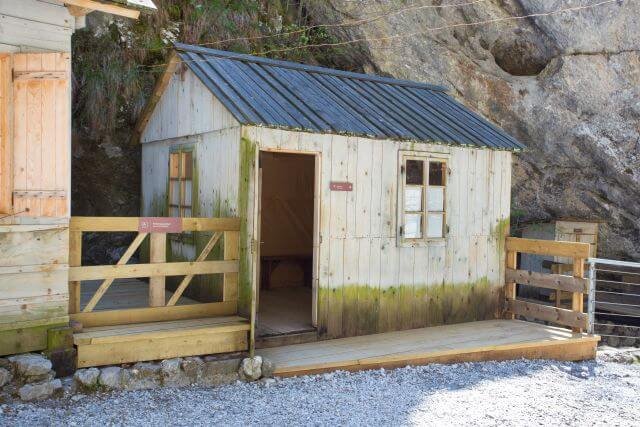

End of hope
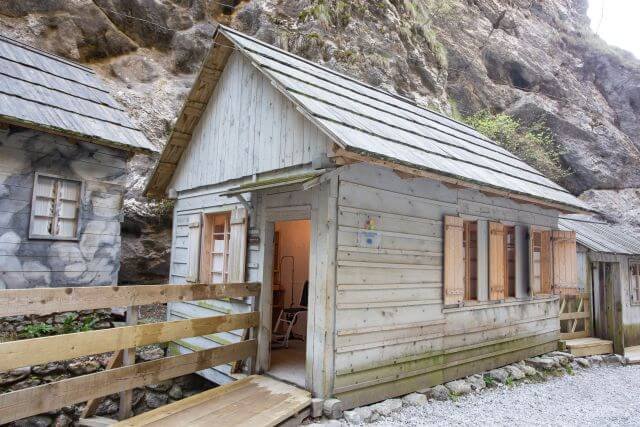
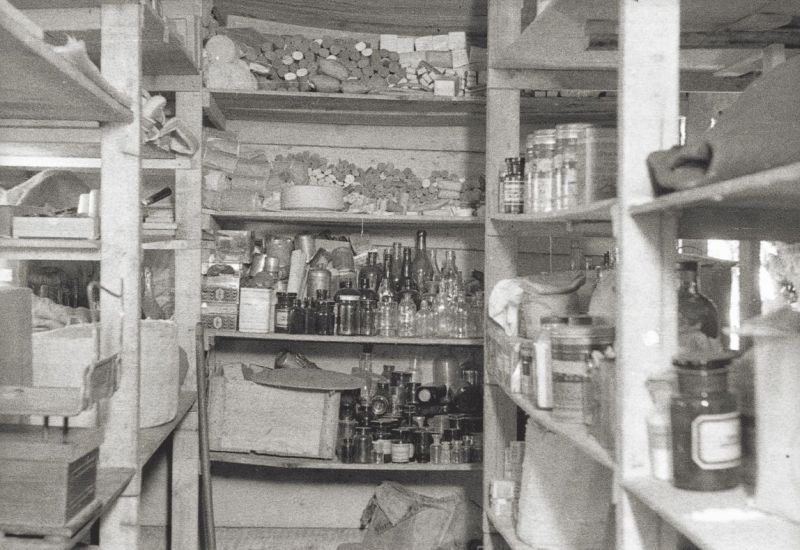
Dressings adn medicines
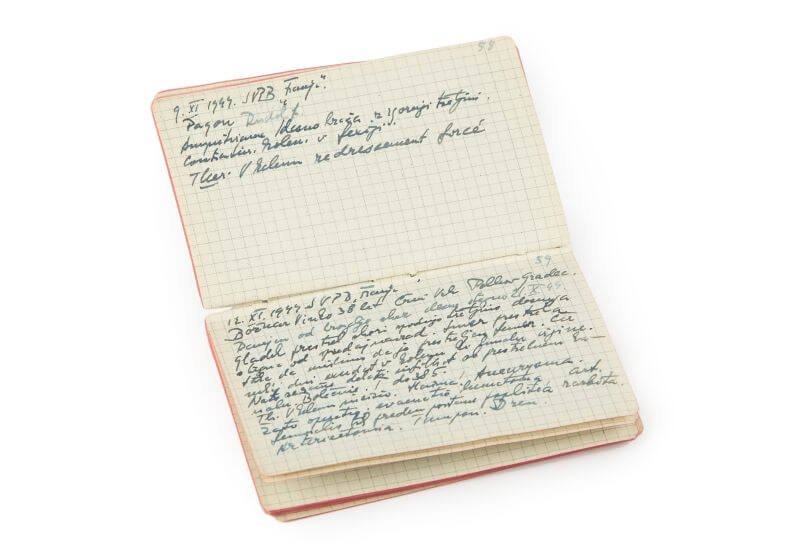
In surgery
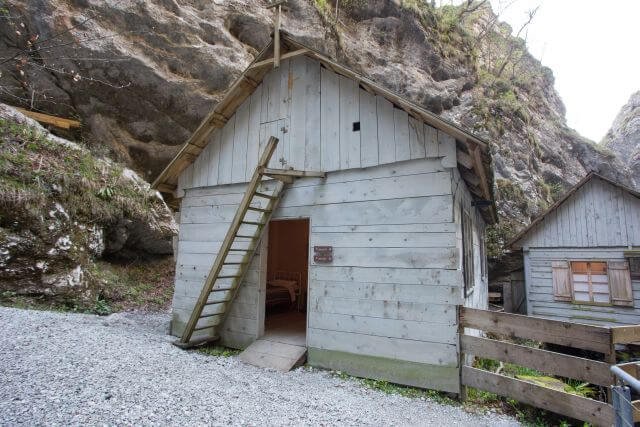
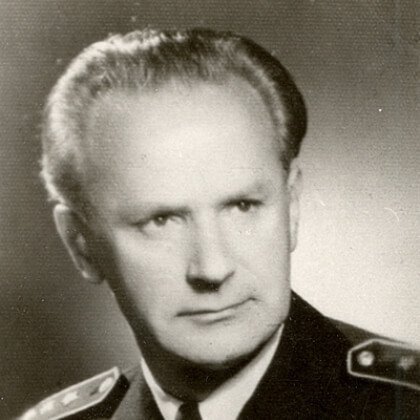
Viktor Volčjak (1913 - 1987)
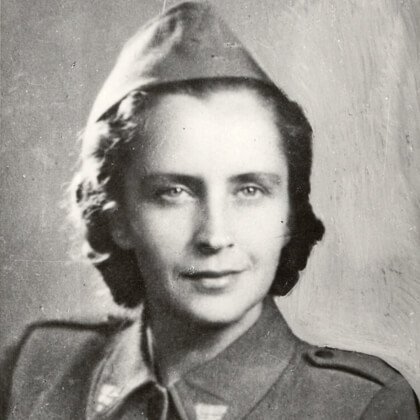
Franja Bojc Bidovec (1913 - 1985)
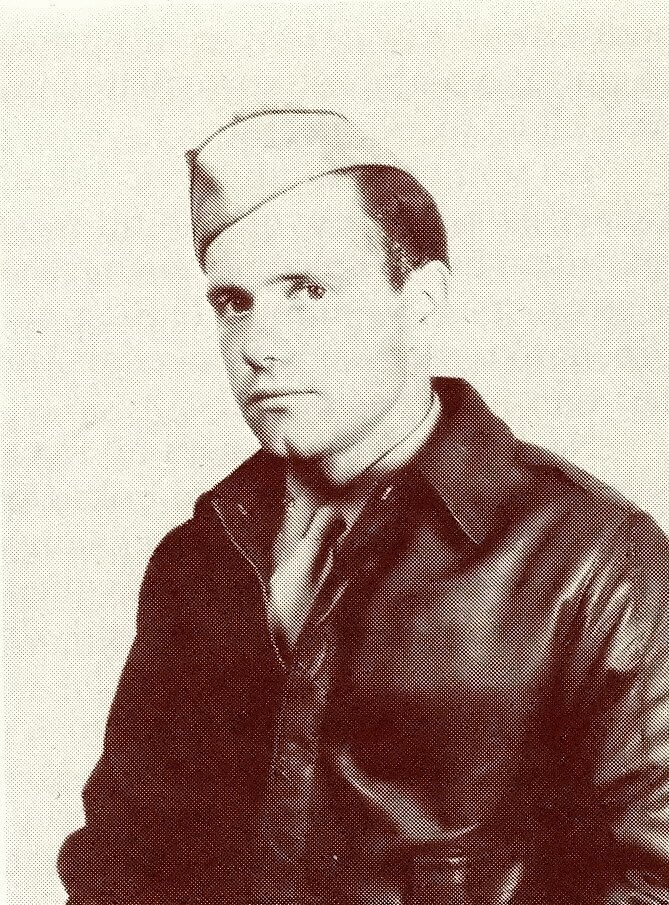
The story of an allied pilot
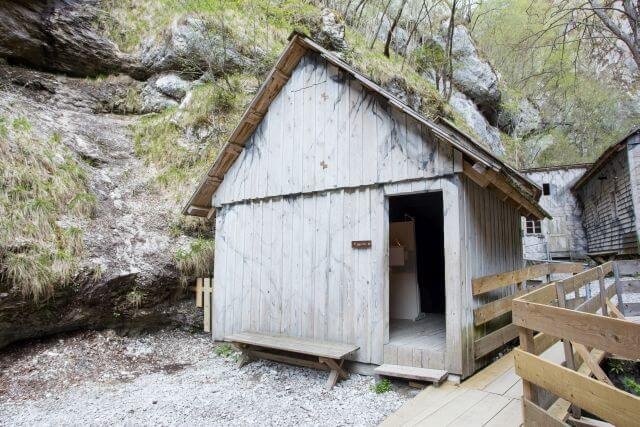
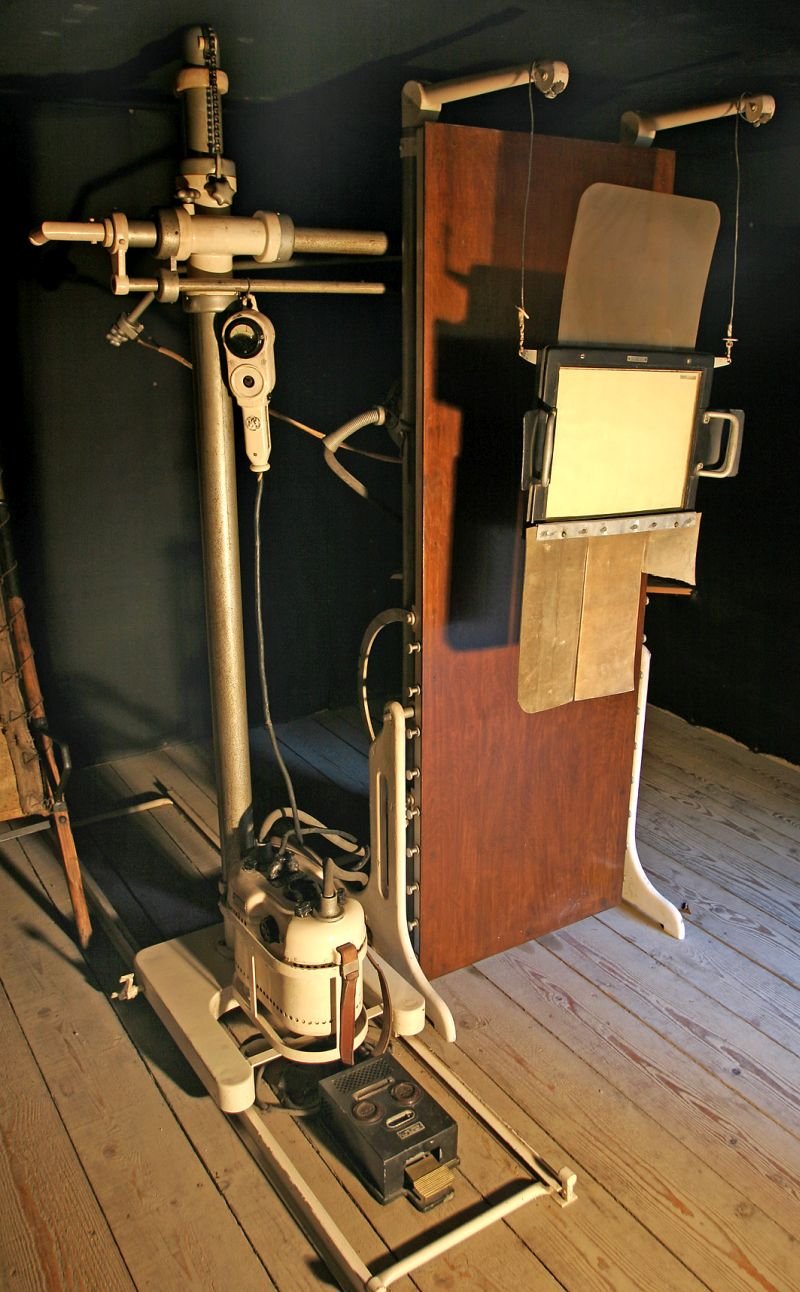
X*ray aparatus - an invalueable acquisition
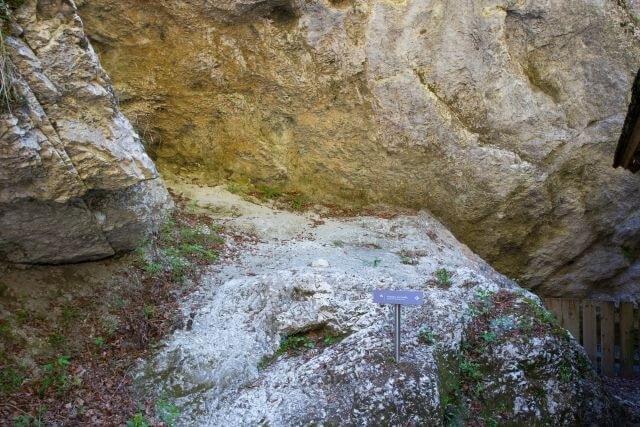
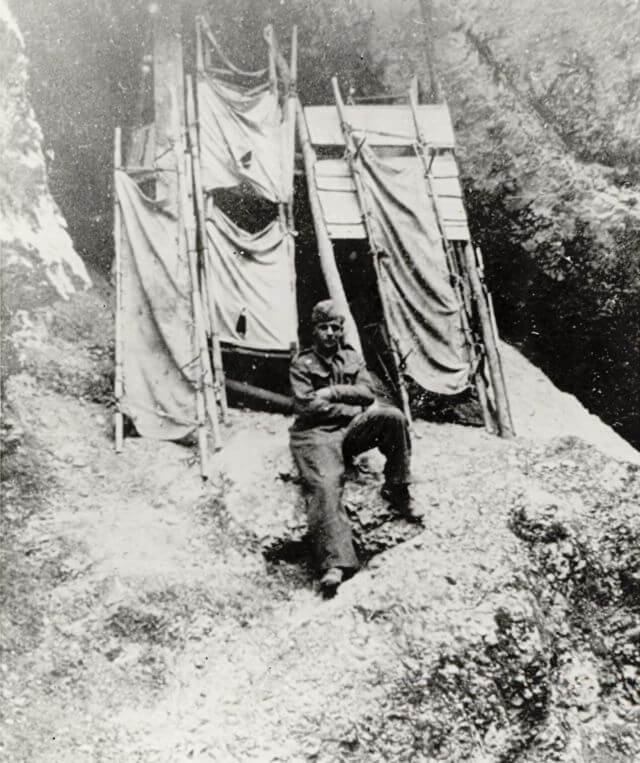
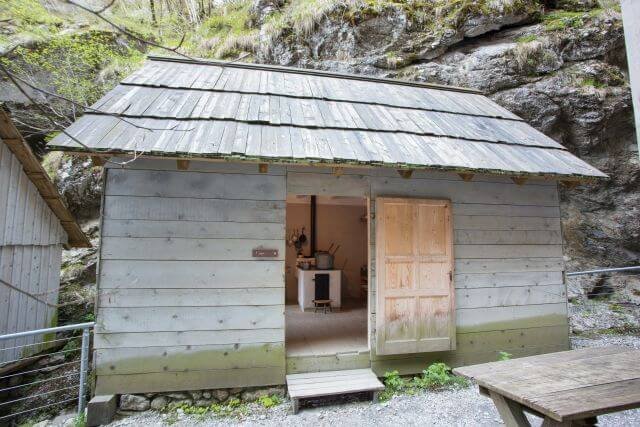
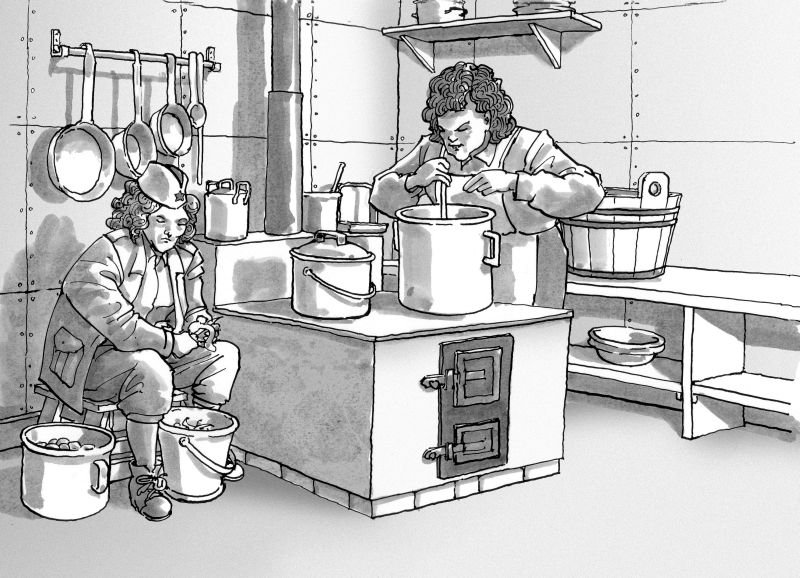
Never empty pot
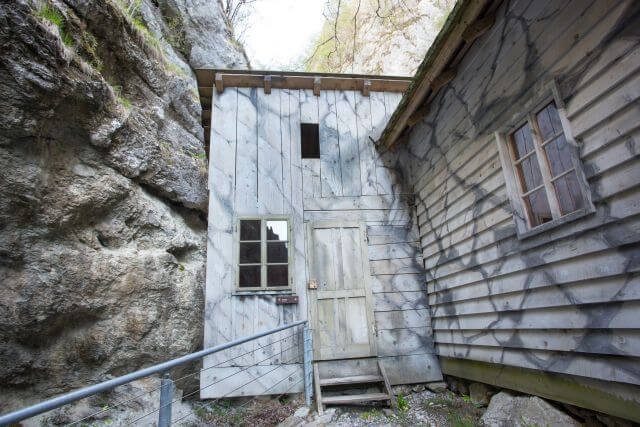
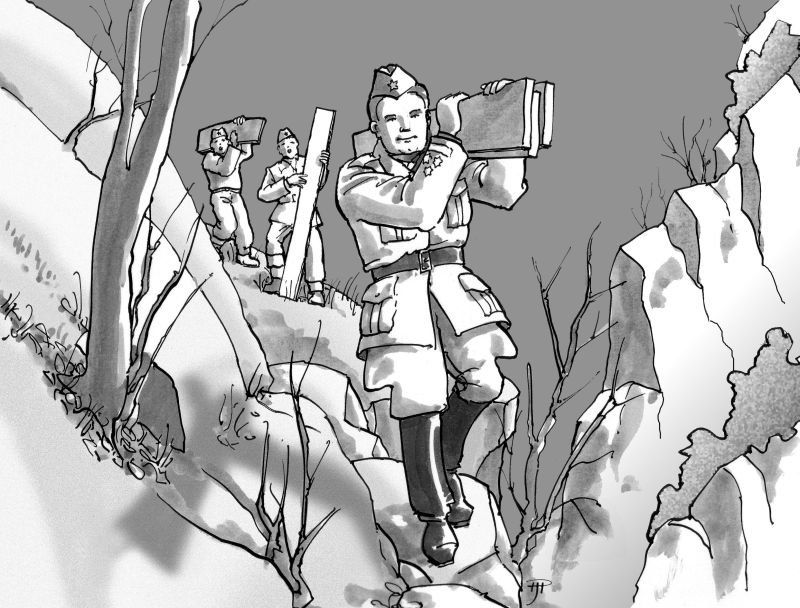
Construction of a post
Departments of the Franja hospital
In department a
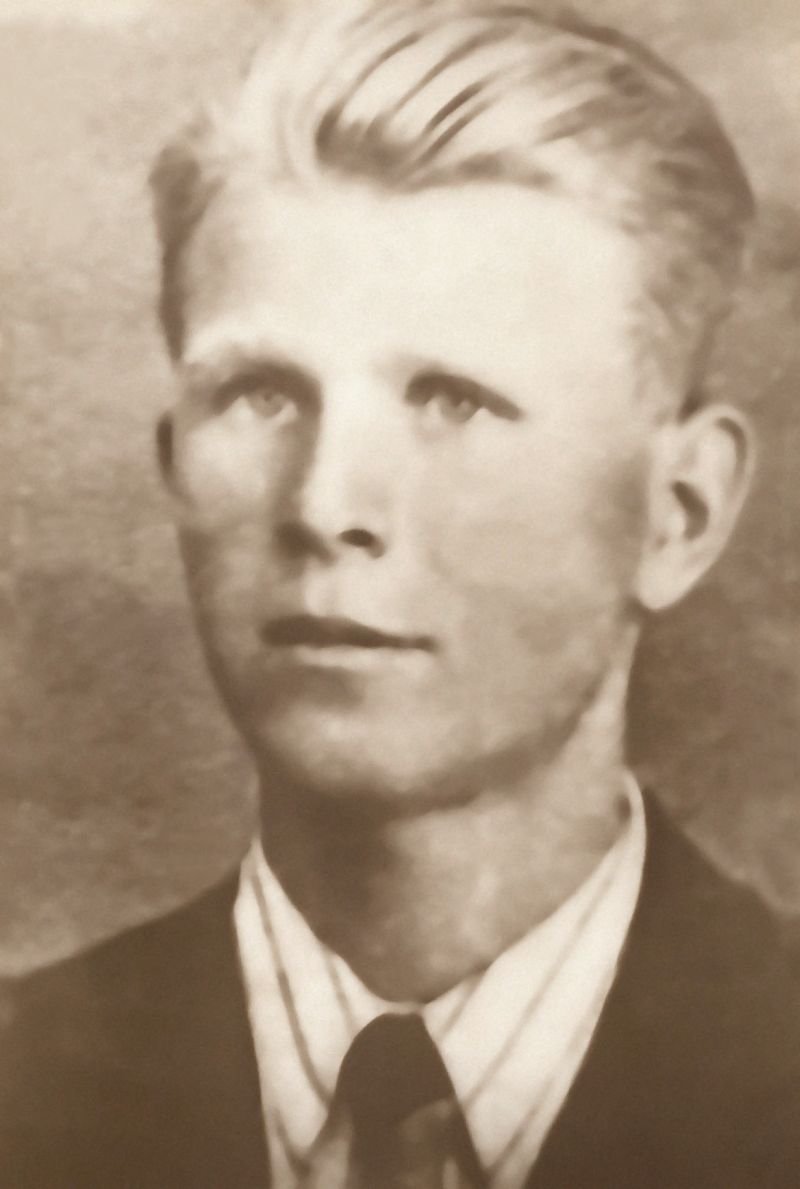
Gašper - the nurse at the communication post
Communication posts
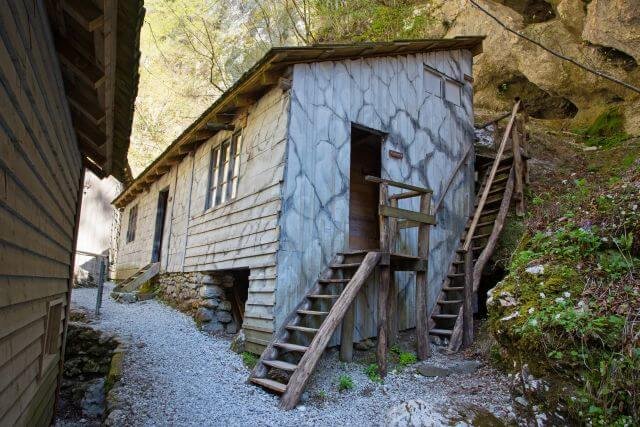
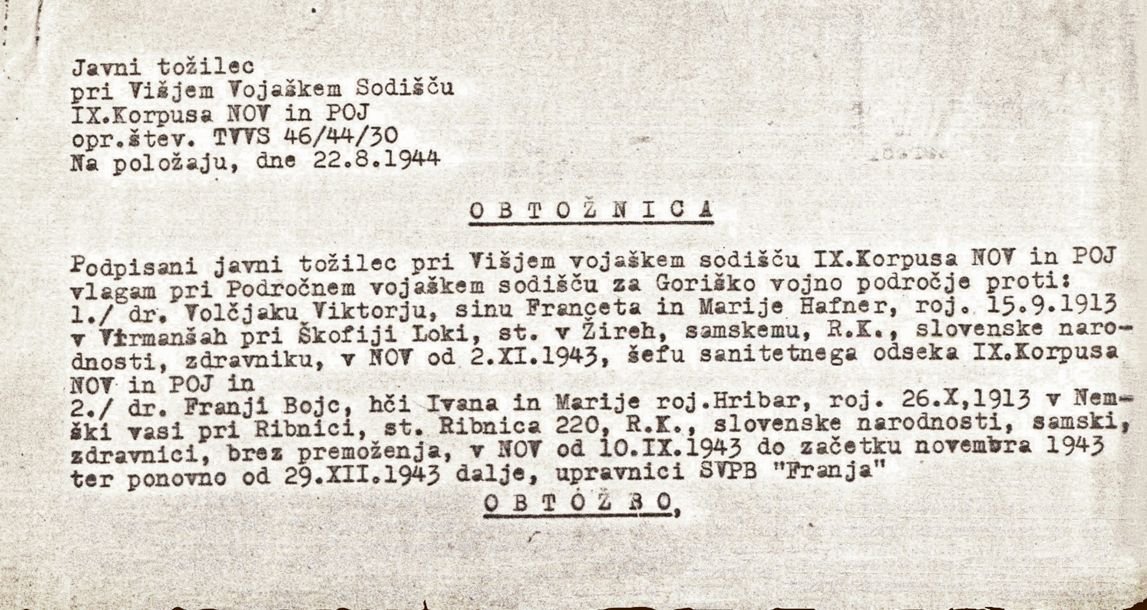
Unjustly accused
Court trial
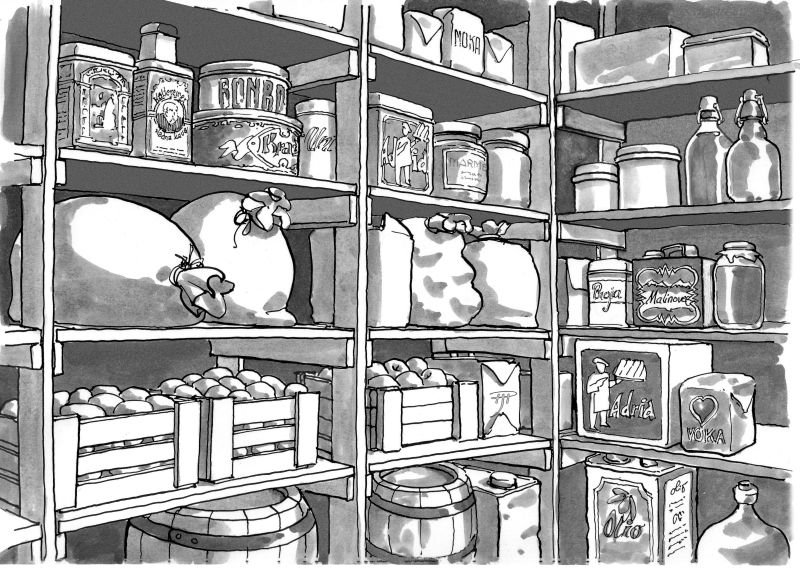
Food storage
Food suply
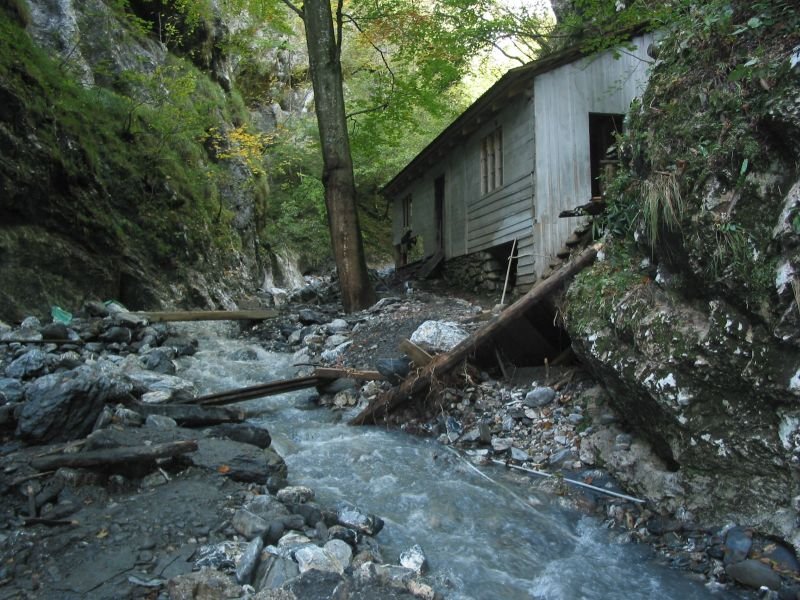
it survived the flood
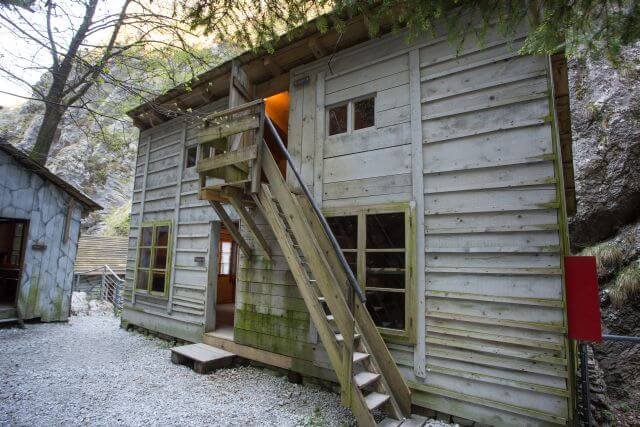
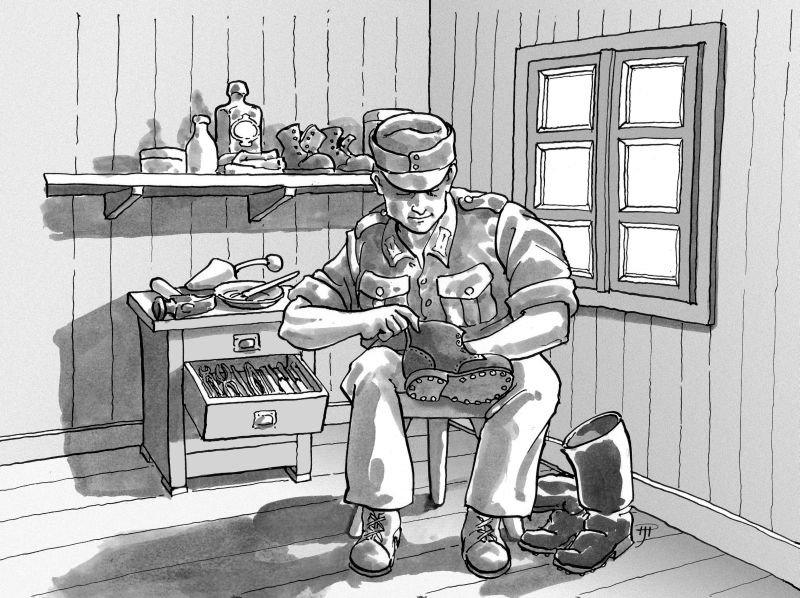
A shoemaker Alois
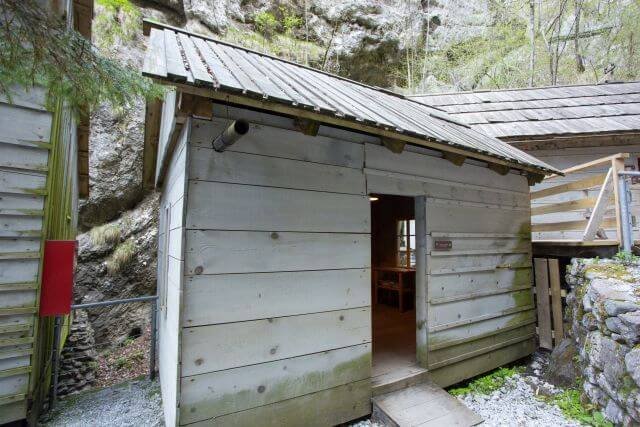
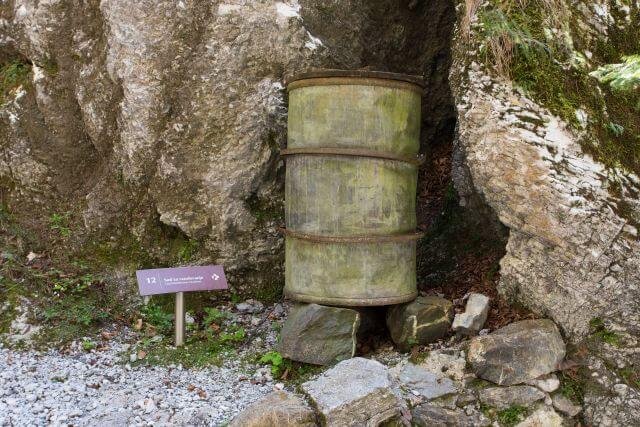
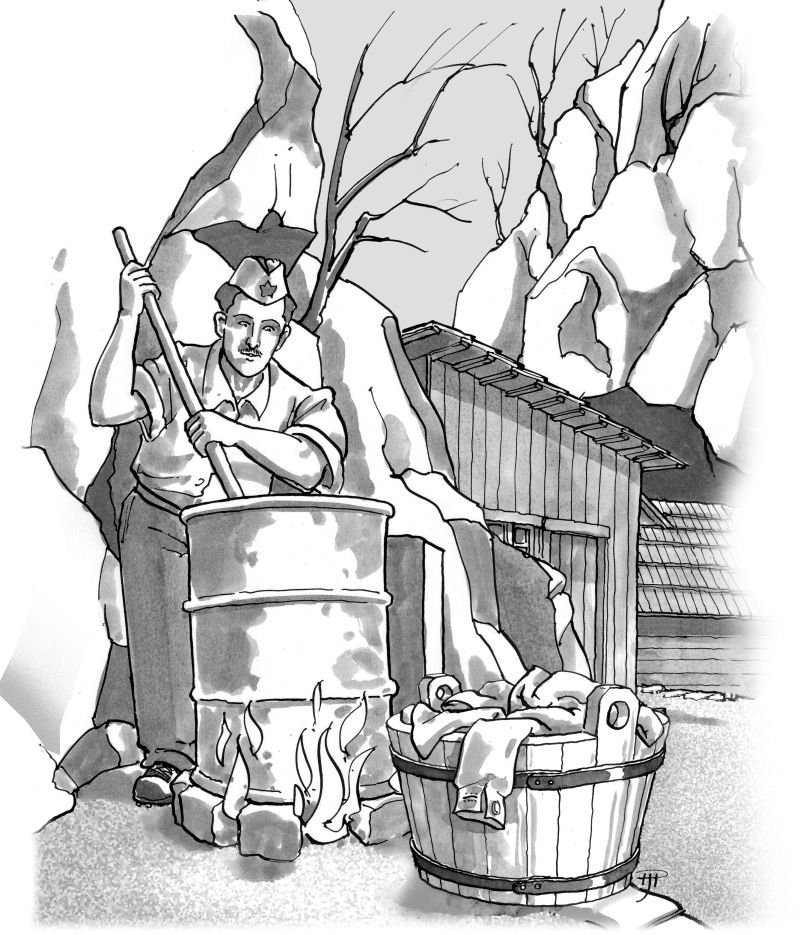
Taking care of the hygiene
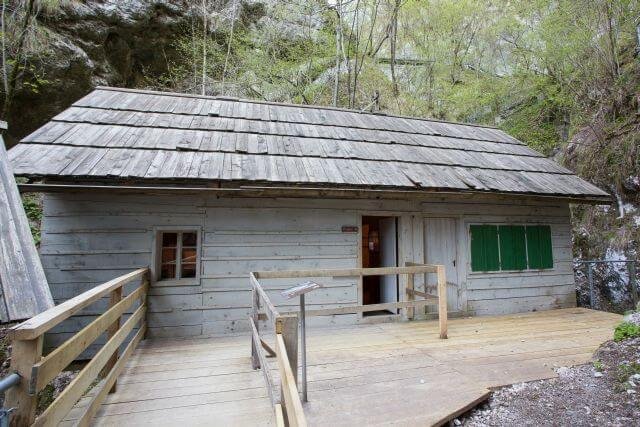
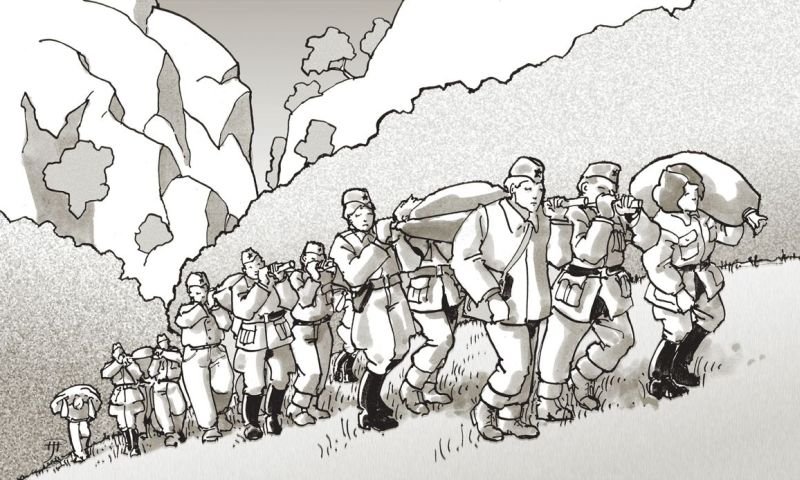
Evacuation to southern Italy
About the evacuation

Meetings and commemorations
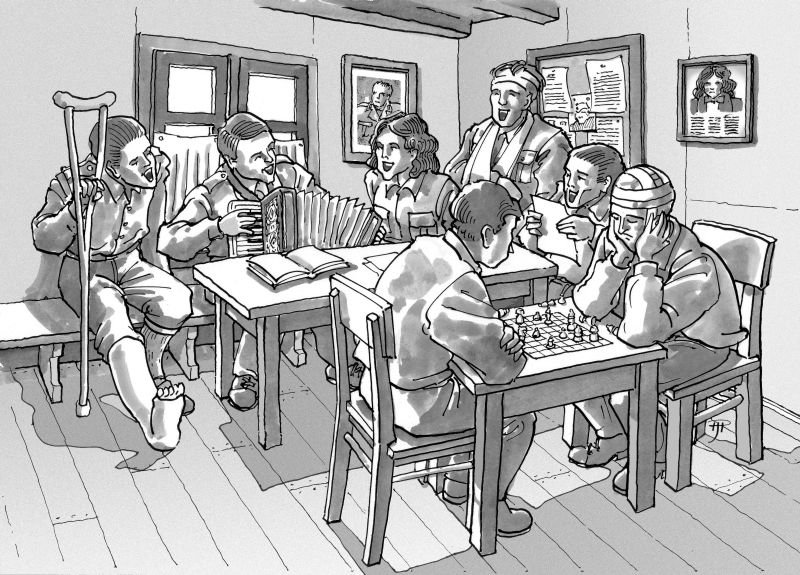
Among invalids
